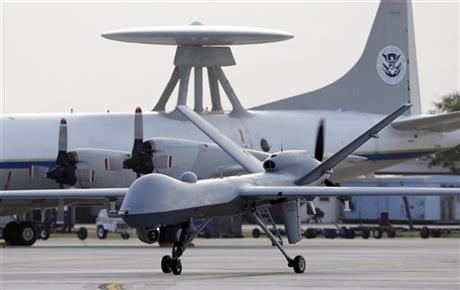
By JOAN LOWY
FILE – In this Nov. 8, 2011 file photo, a Predator B unmanned aircraft taxis at the Naval Air Station in Corpus Christi, Texas. Widespread drone access to U.S. skies faces significant hurdles and will take longer than Congress had anticipated, federal officials acknowledged Thursday as they released a long-term roadmap for drone integration. For the next several years, domestic use of drones will be limited to permits granted by the Federal Aviation Administration on a case-by-case basis to operators who agree to procedures to reduce safety risks, the agency said. (AP Photo/Eric Gay, File)
WASHINGTON (AP) — Widespread drone access to U.S. skies faces significant hurdles and will take longer than Congress had anticipated, federal officials acknowledged Thursday in releasing a long-term roadmap for domestic use of drones.
For the next several years, use of drones will be limited to permits granted by the Federal Aviation Administration on a case-by-case basis to operators who agree to procedures to reduce safety risks, the agency said.
Last year, Congress directed the FAA to grant drones widespread access by September 2015. But the agency has missed several deadlines for steps necessary to make that happen.
Among the concerns are whether remotely controlled drones will be able to detect and avoid other aircraft as well as do planes with pilots on board. There are also security concerns, including whether drones’ navigation controls can be hacked or disrupted.
“Government and industry face significant challenges as unmanned aircraft move into the aviation mainstream,” Transportation Secretary Anthony Foxx said in a statement.
The roadmap has one big gap: privacy, one of the most widespread concerns associated with drones. It addresses only the use of drones at six initial test sites, which have not yet been selected. Test site operators must have a publicly available privacy plan and abide by state and federal privacy laws. The plan must be reviewed annually with opportunity for public comment.
Beyond that, the agency said, privacy isn’t within its purview. “The FAA’s mission does not extend to regulating privacy, but we have taken steps to address privacy as it relates to the six … test sites,” the agency said in response to questions from The Associated Press.
“The FAA is also actively engaged in interagency efforts to develop privacy safeguards as (drones) are integrated into the national airspace,” the statement said.
FAA officials have long contended that, as a safety agency steeped in technology, they have little expertise on addressing broad public privacy worries.
The FAA estimates that within five years of being granted widespread access, roughly 7,500 commercial drones, many of them smaller than a backpack, will be buzzing across U.S. skies.
Industry-local government consortiums around the country are competing fiercely to be selected for one of the test sites. The Teal Group, an industry forecaster in Fairfax, Va., estimates worldwide annual spending on drone research, development, testing, and evaluation procurement will increase from $6.6 billion in 2013 to $11.4 billion in 2022.
The roadmap addresses current and future policies, regulations, technologies and procedures that will be required as demand for drones grows.



